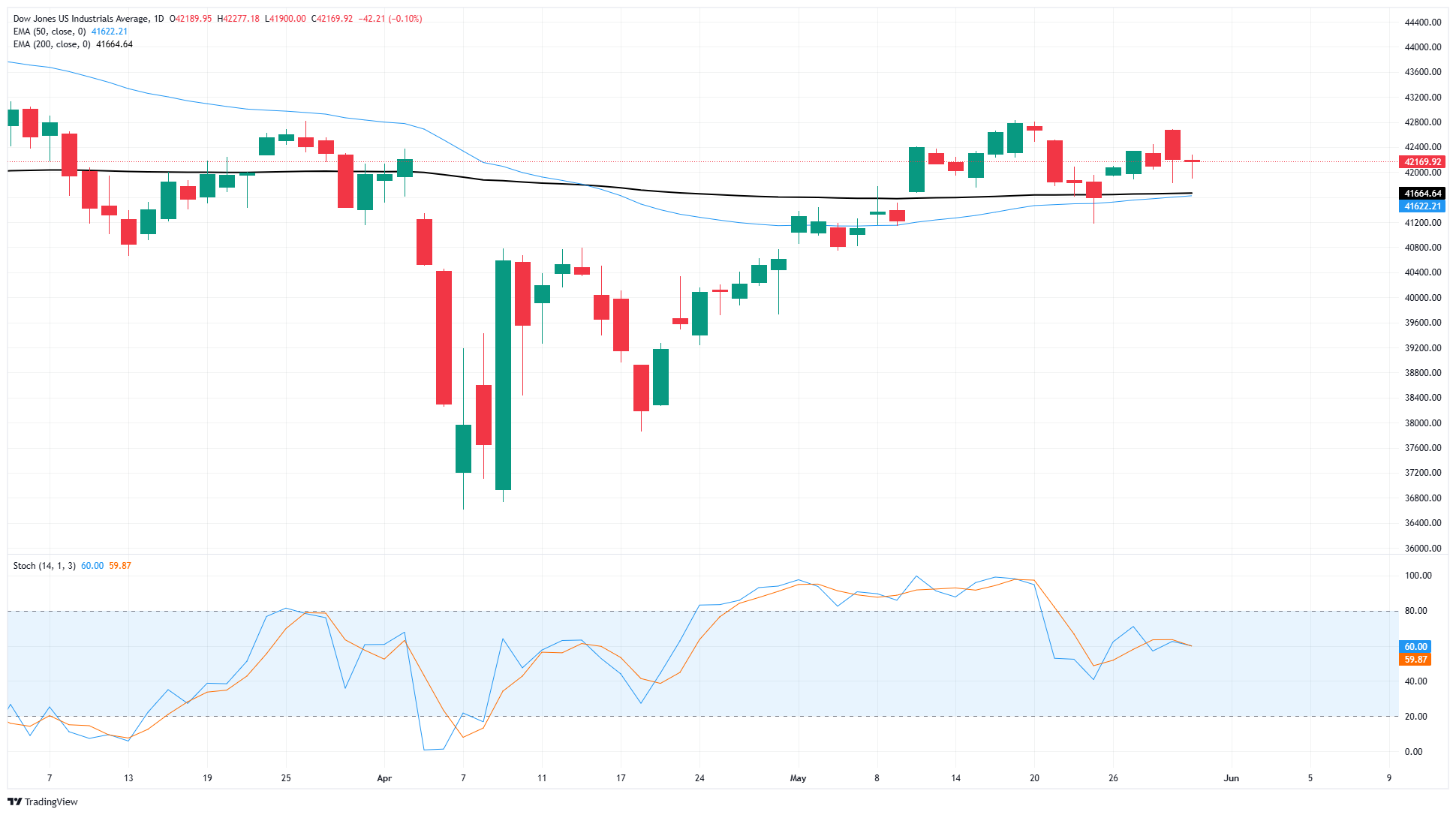Dow Jones Industrial Average hobbled by renewed China trade tensions
- The Dow Jones tested lower on Friday after Donald Trump aimed at China once again.
- Equity markets remain hesitant following this week’s legal snag for Trump’s tariffs.
- US PCE inflation came in as expected, albeit with upside revisions to previous data.
The Dow Jones Industrial Average (DJIA) stumbled on Friday as investors continue to get pummeled with new trade concerns from the White House. United States (US) President Donald Trump has pivoted once again to focus on China, claiming that their preliminary trade arrangements have been “violated”. Despite a general cooling off of key US Personal Consumption Expenditure Price Index (PCE) inflation figures in April, previous data saw an upside revision, and tariff impacts on prices still loom ahead.
Trump renews trade war rhetoric aimed squarely at China
President Trump’s approach to trade policy continues to drive a wedge further into markets, splitting investor sentiment down the middle. Via a social media post, Donald Trump proclaimed that China has “violated” the preliminary trade agreements that the two trade giants agreed to in recent weeks. However, the exact details of what terms have been broken remain unclear. This further frays investors’ nerves, which are already shot after federal judges ruled this week that the Trump administration violated its bounds when using national security laws to enact sweeping tariffs.
Trump’s tariffs are allowed to remain in place while the appeals process gets underway. Unfortunately, this pushes out market hopes for clarity on US trade as the White House looks to get the ruling overturned. Trump staffers have stated they will also be looking for other legal avenues to pursue their trade agenda, presumably with the goal of continuing to entirely circumvent Congress.
According to sources within the administration, the Trump administration is drafting up orders to impose new restrictions meant to curb Chinese access to the US tech industry. The AI tech rally, and the chip-making monoliths that have been profiting from it, are unlikely to respond favorably to President Trump attempting to lock them out of one of the largest AI-hungry markets in the world.
AI-fueled tech tech rally poised to face headwinds from combative trade stance
During this week’s Nvidia (NVDA) earnings call, Nvidia CFO Colette Cress noted that the tech giant is expecting to miss out on approximately 8B in revenue at the hands of already-existing tech restrictions introduced by the Trump administration. Nvidia also expects to remain entirely locked out of the Chinese AI accelerator market, which is expected to grow to 50B in the coming years. Nvidia CEO Jensen Huang suggested that the Trump administration’s approach to tech trade with China is based on the incorrect assumption that China is unable to produce AI-grade chips and processors:
The question is not whether China will have AI, it already does. The question is whether one of the world's largest AI markets will run on American platforms. The US has based its policy on the assumption that China cannot make AI chips. That assumption… It's clearly wrong.
Read more stock news: Tech stocks skid as Trump's aggravation with China, leads to Friday pullback
US PCE inflation matched median market forecasts in April, with annualized PCE Price Index inflation clocking in at 2.5% YoY. However, March’s PCE print was revised higher to 2.7%, limiting any investor celebration as inflation data continues to float stubbornly above the Federal Reserve’s (Fed) 2% target range.
Dow Jones price forecast
The Dow Jones Industrial Average continues to get stuck in the mud near the 42,000 handle as the major equity index threatens to slip into a consolidation period. Price action remains bolstered just above the 200-day Exponential Moving Average (EMA) near 41,590, but upside potential is getting squeezed out of intraday charts. The Dow Jones has slipped into negative territory for 2025, and remains down roughly 6.5% from record highs posted late last year.
Dow Jones chart

Dow Jones FAQs
The Dow Jones Industrial Average, one of the oldest stock market indices in the world, is compiled of the 30 most traded stocks in the US. The index is price-weighted rather than weighted by capitalization. It is calculated by summing the prices of the constituent stocks and dividing them by a factor, currently 0.152. The index was founded by Charles Dow, who also founded the Wall Street Journal. In later years it has been criticized for not being broadly representative enough because it only tracks 30 conglomerates, unlike broader indices such as the S&P 500.
Many different factors drive the Dow Jones Industrial Average (DJIA). The aggregate performance of the component companies revealed in quarterly company earnings reports is the main one. US and global macroeconomic data also contributes as it impacts on investor sentiment. The level of interest rates, set by the Federal Reserve (Fed), also influences the DJIA as it affects the cost of credit, on which many corporations are heavily reliant. Therefore, inflation can be a major driver as well as other metrics which impact the Fed decisions.
Dow Theory is a method for identifying the primary trend of the stock market developed by Charles Dow. A key step is to compare the direction of the Dow Jones Industrial Average (DJIA) and the Dow Jones Transportation Average (DJTA) and only follow trends where both are moving in the same direction. Volume is a confirmatory criteria. The theory uses elements of peak and trough analysis. Dow’s theory posits three trend phases: accumulation, when smart money starts buying or selling; public participation, when the wider public joins in; and distribution, when the smart money exits.
There are a number of ways to trade the DJIA. One is to use ETFs which allow investors to trade the DJIA as a single security, rather than having to buy shares in all 30 constituent companies. A leading example is the SPDR Dow Jones Industrial Average ETF (DIA). DJIA futures contracts enable traders to speculate on the future value of the index and Options provide the right, but not the obligation, to buy or sell the index at a predetermined price in the future. Mutual funds enable investors to buy a share of a diversified portfolio of DJIA stocks thus providing exposure to the overall index.

